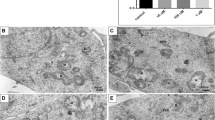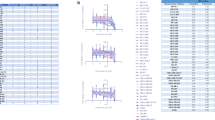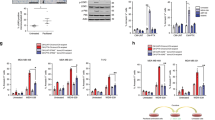Abstract
Superoxide (O2−) radicals have been linked to apoptosis. Here, we show that 2-methoxyestradiol (2ME2)-induced apoptosis in multiple myeloma (MM) cells is associated with O2− generation, whereas dexamethasone (Dex)-induced apoptosis occurs without concurrent increase in O2−. In contrast, both these agents decrease mitochondrial transmembrane potential (Δψm). Treatment of MM cells with an antioxidant N-acetyl-L-cysteine blocks 2ME2, but not Dex-induced apoptosis as well as release of mitochondrial proteins cytochrome c (cyto c) and Smac. Taken together, these results demonstrate that there are at least two distinct apoptotic pathways: one dependent on O2−, which is induced by 2ME2 and is associated with release of cyto c and Smac; and the other an independent of O2−, which is triggered by Dex and associated with Smac release.
This is a preview of subscription content, access via your institution
Access options
Subscribe to this journal
Receive 50 print issues and online access
$259.00 per year
only $5.18 per issue
Buy this article
- Purchase on Springer Link
- Instant access to full article PDF
Prices may be subject to local taxes which are calculated during checkout



Similar content being viewed by others
Abbreviations
- MM:
-
multiple myeloma
- O2−:
-
superoxide
- cyto c:
-
cytochrome c
- Smac:
-
second mitochondrial activator of caspase
References
Bossy-Wetzel E and Green DR . (1999). Mutat. Res., 434, 243–251.
Chauhan D, Catley L, Hideshima T, Li G, Leblanc R, Gupta D, Sattler M, Richardson P, Schlossman RL, Podar K, Weller E, Munshi N and Anderson KC . (2002). Blood, 100, 2187–2194.
Chauhan D, Hideshima T, Rosen S, Reed JC, Kharbanda S and Anderson KC . (2001). J. Biol.Chem., 276, 24453–24456.
Chauhan D, Pandey P, Ogata A, Teoh G, Treon S, Urashima M, Kharbanda S and Anderson KC . (1997). Oncogene, 15, 837–843.
Curtin JM, Donovan M and Cotter TG . (2002). J. Immunol. Methods, 265, 49–72.
Ding M, Li J, Leonard SS, Shi X, Costa M, Castranova V, Vallyathan V and Huang C . (2002). Mol. Cell Biochem., 234–235, 81–90.
Distelhorst CW . (2002). Cell Death Differ., 9, 6–19.
Du C, Fang M, Li Y, Li L and Wang X . (2000). Cell, 102, 33–42.
Du J, Suzuki H, Nagase F, Akhand AA, Ma XY, Yokoyama T, Miyata T and Nakashima I . (2001). Free Radic. Biol. Med., 31, 469–478.
Dussmann H, Kogel D, Rehm M and Prehn JH . (2003). J. Biol. Chem., 278, 12645–12649.
Guo F, Nimmanapalli R, Paranawithana S, Wittman S, Griffin D, Bali P, O'Bryan E, Fumero C, Wang HG and Bhalla K . (2002). Blood, 99, 3419–3426.
Hockenbery DM, Oltvai ZN, Yin XM, Milliman CL and Korsmeyer SJ . (1993). Cell, 75, 241–251.
Huang P, Feng L, Oldham EA, Keating MJ and Plunkett W . (2000). Nature, 407, 390–395.
Kaufmann SH, Desnoyers S, Ottaviano Y, Davidson NE and Poirier GG . (1993). Cancer Res., 53, 3976–3985.
Li N, Ragheb K, Lawler G, Sturgis J, Rajwa B, Melendez JA and Robinson JP . (2003). Free Radic. Biol. Med., 34, 465–477.
Liu X, Naekyung Kim C, Yang J, Jemmerson R and Wang X . (1996). Cell, 86, 147–157.
Matsuyama S and Reed JC . (2000). Cell Death Differ., 7, 1155–1165.
Ng CP, Zisman A and Bonavida B . (2002). Prostate, 53, 286–299.
Poot M and Pierce RH . (1999). Cytometry, 35, 311–317.
Rothe G and Valet G . (1990). J. Leukoc. Biol., 47, 440–448.
Verhagen M, Ekhert PG, Pakusch M, Silke J, Conolly LM, Reid GE, Moritz RI, Simpson RJ and Vaux DL . (2000). Cell, 102, 43–53.
Wang Z, Van Tuyle G, Conrad D, Fisher PB, Dent P and Grant S . (1999). Cancer Res., 59, 1259–1267.
Zamzami N, Marchetti P, Castedo M, Decaudin D, Macho A, Hirsch T, Susin SA, Petit PX, Mignotte B and Kroemer G . (1995). J. Exp. Med., 182, 367–377.
Acknowledgements
This investigation was supported by NIH Grants 50947 and CA 78373, a Doris Duke Distinguished Clinical Research Scientist Award (KCA), The Myeloma Research Fund, and The Cure Myeloma Fund.
Author information
Authors and Affiliations
Corresponding author
Rights and permissions
About this article
Cite this article
Chauhan, D., Li, G., Sattler, M. et al. Superoxide-dependent and -independent mitochondrial signaling during apoptosis in multiple myeloma cells. Oncogene 22, 6296–6300 (2003). https://doi.org/10.1038/sj.onc.1206734
Received:
Revised:
Accepted:
Published:
Issue Date:
DOI: https://doi.org/10.1038/sj.onc.1206734
Keywords
This article is cited by
-
Proteomic analysis identifies mechanism(s) of overcoming bortezomib resistance via targeting ubiquitin receptor Rpn13
Leukemia (2021)
-
Sophoridine induces apoptosis and S phase arrest via ROS-dependent JNK and ERK activation in human pancreatic cancer cells
Journal of Experimental & Clinical Cancer Research (2017)
-
Induction of the intrinsic apoptotic pathway via a new antimitotic agent in an esophageal carcinoma cell line
Cell & Bioscience (2014)
-
Ordering of neuronal apoptosis signaling: a superoxide burst precedes mitochondrial cytochrome c release in a growth factor deprivation model
Apoptosis (2012)
-
Molecular consequences of SOD2 expression in epigenetically silenced pancreatic carcinoma cell lines
British Journal of Cancer (2007)



